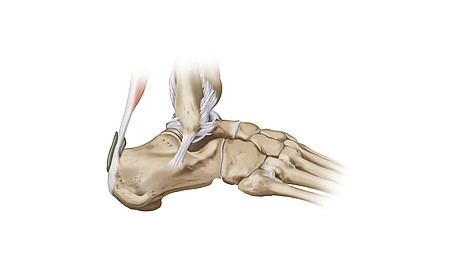Quickly to the topic:
What is ankle instability?
Repeated injuries or structural weaknesses can lead to chronic instability of the ankle joint. A distinction is made between mechanical instability and functional instability:
Mechanical instability | Functional instability |
| Mechanical instability is a structural ligament instability - often acute after an injury with accompanying capsule-ligament weakness. | This is a subjectively perceived insecurity when walking with a lack of joint control and poor self-perception (proprioception). The functional instability is long-term - often after a trauma that occurred some time ago. |
Chronic instability often occurs, for example, after supination trauma caused by twisting the ankle outwards. Chronic ankle instability can be accompanied by concomitant or long-term damage such as chronic pain.
Causes and risk factors: How does chronic ankle instability develop?
Instability is a common consequence of repeated ligament sprains or tears, particularly of the lateral (outside) ligaments. The risk of chronic instability of the ankle joint is already significantly increased after an initial sprain and with inadequate initial sports medicine treatment. Inadequate healing or weakening of the capsule-ligament structures can also result in chronic instability.
Other causes of chronic instability in the ankle joint can be muscle weakness or impaired neuromuscular control, for example a delayed reaction of the stabilizing muscles. Accompanying cartilage damage or osteoarthritits due to long-term incorrect loading can also lead to instability.
These symptoms and signs indicate ankle instability
Chronic instability in the ankle joint is characterized by a feeling of insecurity when walking - especially on uneven ground, repeated twisting of the ankle, pain and swelling as well as restricted movement. Even if the symptoms subside over time, the instability can persist. Those affected often believe that there is no longer any need for action - this is a misconception.
Can an unstable ankle joint be prevented?
In the case of acute injuries, early treatment is crucial in order to avoid mechanical and functional instability of the ankle joint at a later stage:
- Consistent treatment after an ankle sprain, for example with the PECH rule (rest, ice, compression, elevation)
- Avoidance of overloading to prevent further ligament injuries
- Physiotherapy to fully restore mobility and stability after an injury
Targeted stabilization, strengthening and coordination measures are suitable for preventing chronic instability of the ankle joint. These can significantly reduce the risk of chronic instability, especially for athletes or people with ankle injuries. Proprioceptive training, for example exercises on unstable surfaces such as balance pads or wobble boards, helps to improve neuromuscular control.
Wearing stabilizing supports or orthoses, especially during sporting activities or after previous injuries, can protect against further injuries.
Medical diagnosis "Chronic instability of the ankle joint"
Chronic ankle instability is diagnosed by taking a medical history (patient interview), clinical examination and imaging procedures. Doctors first ask about the frequency and type of twisting (e.g. spontaneous or only during exercise) as well as accompanying symptoms such as pain, swelling and a feeling of insecurity. Previous injuries such as torn ligaments or sprains are also taken into account. The clinical examination also includes various functional tests:
- Drawer test checks the stability of the anterior talofibular ligament (anterior displacement of the talus)
- Inversion and eversion test: Checking the lateral ligament structures
- Single-leg stance and balance tests to assess proprioception and muscle control
Imaging procedures such as X-rays, magnetic resonance imaging (MRI), diagnostic arthroscopy and ultrasound provide an internal view and allow conclusions to be drawn about the structural causes of the instability.
Once the diagnosis has been established, for example mechanical instability in the form of structural post-traumatic ligament instability or functional instability with reduced joint control, targeted therapy can be initiated.
Treatment options: Therapy for ankle instabilities
If the ankle joint is unstable, conservative functional therapy is the first priority. Conservative therapy involves physiotherapy. Proprioceptive training can improve the functional stability of the ankle joint. Medical aids such as ankle supports are often used to prevent recurring supination trauma.
If conservative measures do not lead to the desired improvement, surgery may be necessary. The affected ligaments can be reconstructed or replaced.
Exercises for instability of the ankle joint
In the case of ankle instability, it is important to stabilize and strengthen the muscles again. Benefit from exercises that increase coordination and stability in the ankle joint.
Products from medi for chronic instability in the ankle joint
The medi Ankle brace and medi Ankle RTS ankle braces stabilize the upper and lower ankle joint in the event of mechanical ligament instability. The Levamed stabili-tri orthosis can be used for functional instabilities and unsteadiness when walking. If medically necessary, an ankle orthosis from medi can be prescribed by a doctor






